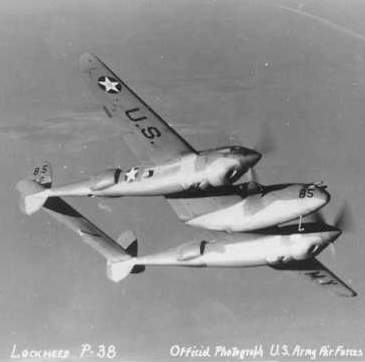|
 THE BOLERO MISSION
THE BOLERO MISSION
 Early Model P-38 Shown in an Official USAAF Photograph. |
� � With the U-Boat threat shipping the aircraft overseas by ship could only be accomplished through convoys, thus "Operation Bolero" was formulated, which called for the trans-Atlantic crossing by air. While this was feasible for most bombers and transports only one fighter aircraft had the necessary range to complete the four-leg journey, the P-38 Lightning. At the time the 1st., 14th. and 82nd. Pursuit Groups* were the only Groups then equipped with this aircraft. � � The P-38 had just entered service as America was drawn into the war and was still having it's share of teething problems, mostly attributable to its Allison V-1710 engines' lack of realibility. The aircraft were also not equipped with the necessary navigational tools to complete such a mission. With the added fuel made available by newly-developed 150 gallon external fuel tanks this would give the aircraft a theoretical range that would leave a margin of nearly one hour. This was all theory, as such a mission had never been attempted. It must also be noted that this was only 15 years after Lindbergh's historical first solo flight. � � On 29 April the 1st. Pursuit Group, then stationed in California, were put on alert status. On May 14th. their orders arrived and five days later the newly designated 1st. Fighter Group's air echelon began to depart for Dow Field, Maine. One of the first stops was the Lockheed plant, where the group received 85 new P-38Fs, this was followed by stops in El Paso, Texas; Barksdale, Louisiana; Patterson Field, Ohio; Mitchell Field, New York and finally Bangor, Maine. By May 25th. all three squadrons had arrived on the east coast. The 1st. FG's ground echelon traveled across the country by train and arrived at Fort Dix, New Jersey. On June 4th. the ground echelon boarded the ocean liner Queen Elizabeth for the five day journey to England. � � The deployment across the Zone of Interior had been good practice for long-distance and high altitude flying, but training in continued once the 1st.FG had settled in at Dow Field. This mission ahead was had the potential for disaster and the pilots needed to be at their best, so the duration of these practice missions continued to lengthen. Training progressed smoothly and it was decided the first flights would take place some time in early June. Weather conditions would be the final deciding factor as to the exact date. � � The battle of Midway loomed on the horizon and the War Department suddenly reconsidered their earlier decision to focus on the European Theater. The 1st. FG was ordered back to their base in California to help defend the West Coast should the Japanese offensive succeed in their palns to smash the US Pacific Fleet. On June 6th the news arrived that the Japanese Forces were in retreat and had lost four aircraft carriers, so the group was ordered to return to Maine and prepare again for the Bolero mission. On 24 June they began to deploy on the first leg of the trans-Atlantic flight. Flights departed throughout most of the day. � � The route the group would take ran from Bangor to Goose Bay Labrador, then to Greenland, Iceland and finally Scotland. Because of their aircraft's meager navigational instrumentation the P-38s would fly in groups of five aircraft with a B-17 fromthe 97th. Bomber Group as a mother ship. The reamining men of the air echelon would make the trip aboard C-47 transports. � � The first leg was uneventful until, after an eight hour flight the pilots found themselves facing the prospect of landing on a single, primative 1,500 foot gravel runway at Goose Bay. Though the southern end of the runway was illuminated with electric lights, the reaminder was marked only by trees. Despite this all landed safely. � � The second leg, to the West-coast of Greenland, was longer in duration however there were two possible fields that the planes could land at, Bluie-West One(BW1), 780 miles away, and Bluie-West Eight (BW8). The latter was the prefered strip to land at but it was nearly 220 miles further away. � � The third leg was from BW1 or BW8 to Reykjavik, Iceland. Upon arriving there the 27th.FS, 1st.FG were ordered to remain there and help defend the area. The remaining squadrons continued on and on July 9th. Col. John L. Stone led seven P-38s to Prestwick, Scotland, being the first 1st.FG aircraft to complete the journey. The rest of the 94th. and 71st. were still strung out along each stop of the route, on 14 July 6 94th.FS P-38s and two B-17s took off from Greenland for Iceland but were forced down on an icecap. (For more on this see the "Lost Squadron/Glacier Girl" and "Operation Snowcone" links below.) These 25 men were all safely rescued by dog sled and what could've been a major disaster was averted. By 31 July the official reports had the 1st. FG ready for action in England. By 27 September the Group was in the air over the ETO. � � Operation Bolero lasted from June, 1942 to January, 1943. A total of 366 heavy bombers, 150 medium bombers and 185 P-38s were delivered to England. The AAF restricted the P-38 from further trans-Atlantic flights in the fall of 1942, so the 82nd.FG was transported to England aboard ship. The winter of 1942-43 caused a rise in the accident rate for all aircraft making the crossing and the Operation was soon canceled. As a final punctuation mark to Bolero, the equipment for Bluie West 8 was destroyed by German submarine and plans to make it a permanent base were abandoned as the winter set in. |
THE LOST SQUADRON & THE GLACIER GIRL P-38 *= The Groups were redesignated as Fighter Groups in May of 1942 |
� �
